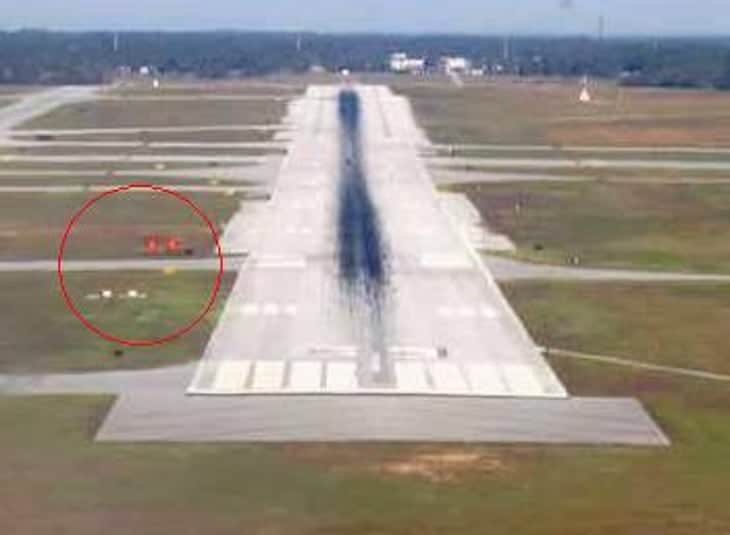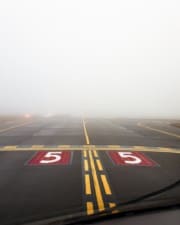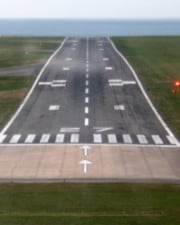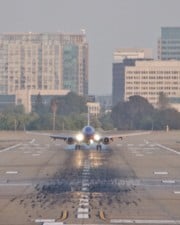Of all of the colored lights that twinkle at an airport, VASI lights are some of the most interesting. These lights change color depending on where the viewer is, and they help pilots find their way to the runway. Day or night, they are present at nearly every airport in the world.
Table of Contents
The VASI light system is mounted next to the end of the runway, and they serve several critical functions for the pilot. They give the pilot an instant understanding of their position from the runway vertically, depending on how far away they are.
For student pilots, seeing how the VASI works for the first time and understanding how helpful it is to them is nothing short of magic. It’s a brilliantly simple system, but the amount of help it gives to pilots is phenomenal.
What is a VASI?
VASI (pronounced “VAZ-ee”) stands for Visual Approach Slope Indicator. It is a set of lights mounted next to the approach end of a runway that helps a pilot align themselves with the invisible vertical approach path.
The runway centerline and the runway itself help the pilot align longitudinally, or left and right of center. But how does a pilot know if they are too high or too low? It’s actually quite a challenge when you think about it.
A VASI is a set of two or three bars, each on top of the other. The lights that make up the bars appear red or white from the pilot’s point of view, depending on the aircraft’s position. Another standard system found at airports has four lights set side-by-side. That’s known as a PAPI (“PAH-pee” or precision approach path indicator).
VASIs and PAPIs are by far the most common glidepath systems in the world. All of the world’s major airports have them installed at each runway. Only very small or private airports will have no glideslope alignment system at all.
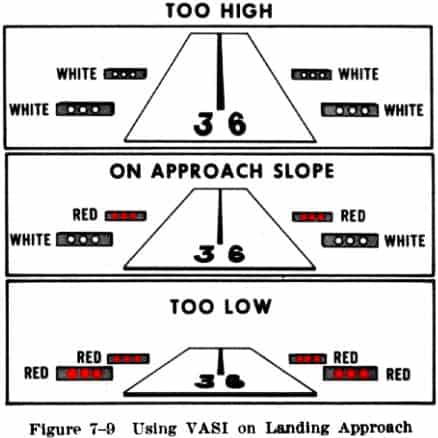
Why VASIs Are So Important?
Besides VASIs or alternate glidepath systems, pilots have no way to tell if they are too high or too low when approaching a runway. In many cases, especially in small easy to maneuver aircraft, it doesn’t really matter. Part of pilot training is learning to approach and land a runway at steep and shallow angles, so a pilot should ideally be able to handle it.
But VASIs provide a valuable tool for pilots to use as a guide. They are vital in pilot training when a pilot doesn’t yet have the experience to use other visual clues to determine their glide path. And they are a huge help when a pilot visits a new airport.
Runways come in all shapes and sizes, and approaching a strange runway can mess with a pilot’s perceptions. Especially when first learning, pilots have a lot of trouble determining which visual cues are the right ones to use. Approaching a strange runway at a new airport changes many of these small cues, like the surrounding terrain’s details.
Some runway visual illusions can mess with the best, most experienced pilots. For example, if a runway is built in hilly terrain, it can have a slope. When viewed on the final approach, an upsloping runway makes it look like the plane is too low. A downsloping runway has the opposite effect, making the pilot feel like they’re too high.
The width of the runway is a significant visual cue for the pilot as well. If a pilot is used to approaching a 100-foot wide runway and visit an airport with a 50-foot wide runway, their approach will feel much different. When that pilot is at 100 feet above the narrower runway, their experience will tell them they are still much higher. The visual picture they have of being 100 feet off the ground is based on what a 100-foot wide runway looks like. Remember, there is no instrument in the cockpit that measures actual height above the terrain in a small aircraft.
The final reason that VASIs are so helpful has to do with the environment outside of the airport. In the US, airports are certified by the FAA, just like pilots and airlines are. There are very tight standards about how tall obstacles can be in the approach path to a runway.
When a pilot approaches a certified public-use airport, they can be assured that the approach path is clear. The standard approach path is calculated as a three-degree glidepath, extending out and up from the runway threshold. If anything dangerous projects up into this glidepath, the landing threshold will be displaced farther down the runway until the approach is clear.
But how can a pilot identify a three-degree glidepath? For visual flying pilots, no instrument tells them where that is. This is why the VASI, or an alternate glidepath system, is so important. It provides that information to the pilot so they can tell very quickly whether they are getting dangerously low.
The standard approach angle and desired glidepath at most airports are three degrees, but this isn’t always the case. There are some airports with mountains around or obstacles that can’t be avoided. If the airport is only used in visual conditions, the VASI might be aligned to a different steeper angle. The VASI’s precise angle at an airport is listed in the FAA digital Chart Supplements (d-CS).
Types of VASI
There are only two types of VASI, even though several other glidepath systems share the name.
- The two-bar VASI consists of two parallel light bars located one on top of the other along the side of a runway.

- The three-bar VASI adds one more light bar. A three-bar VASI can be found at larger airports, where bigger airplanes are flown. The upper glidepath is added so that pilots in very tall and very large airplanes can use it. If they used the lower glidepath, their wheels might touchdown before the runway threshold.

How Does a VASI Work?
The individual lightboxes that make a VASI work are made of two light bulbs with a solid divider between them. The red light is below the white light. The box itself is mounted to the ground at the angle at which you want the light to change.
So while the VASI sounds and looks pretty complicated, it’s very simple. It’s a lightbulb in a box, and the entire principle of its operation relies on the plane’s position relative to it.
VASIs are on day and night. They are visible for at least three to five miles during the day and up to twenty miles at night. VASI systems contain either two, four, six, twelve, or sixteen individual lights. Twelve and sixteen light systems have lights positioned on both sides of the runway; otherwise, all lights are usually on the runway’s left side.
The precise details of VASI installations and their layouts are covered in the Aeronautical Information Manual, Section 2-1-2.
How Does a Pilot Use a VASI?
When viewed from the cockpit, the lights of a VASI change from white to red when the plane descends below the angle at which the lights are aligned. The upper bar is set slightly higher than three degrees, while the lower bar is set slightly lower than three degrees. If the pilot is right on a three-degree glidepath, then the farther bar should be red, and the nearer bar should be white.
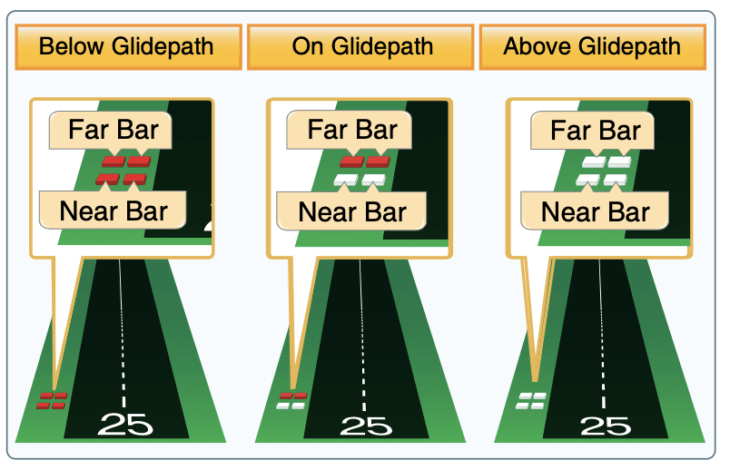
Pilots learn this little poem to remember the right light combinations.
White over white, check your height.
Red over white, you’re all right.
Red over red, you’re dead.
Ideally, a pilot will fly a stable approach in a straight line to the runway threshold, seeing red over white the entire time. It seldom happens that way in the real world, and the pilot winds up seeing that they’ve gotten too high or too low and must make an appropriate correction.
Note – the combination of seeing a white over a red light is not possible. Many pilots joke that if they were inverted, it would appear that way. But that isn’t very clear. There is no way for the far bar to appear white and the near bar to appear red.
Other Types of Glidepath Systems
There are several other systems available that are installed at airports. Beyond VASIs and PAPIs, the others are not at all common.
PAPI
A PAPI gives the pilot a little more detail than the VASI, and that’s why it’s called the precision approach path indicator. The lights of a PAPI work precisely like those on a VASI, but they are mounted side by side. A two-light PAPI will show the same three-degree glidepath that a VASI would.
However, a four-light PAPI is arranged so that the pilot can get an indication of being “slightly high” or “slightly low.”
- Four white lights – Too high
- Three white lights, one red – Slightly high
- Two white lights, two red – Perfect three-degree glidepath
- One white light, three red – Slightly low
- Four red lights – Too low

Tricolor VASI

A tricolor VASI shows the three-degree glidepath but with a single color-changing light bulb.
- Amber – Too high
- Green – Perfect three-degree glide path
- Red – Too low
Pulsating VASI
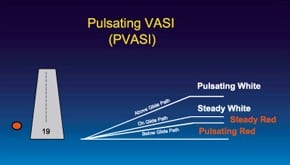
Very similar to the tricolor is the pulsating VASI or P-VASI. This unit has one light that appears either pulsing or stead, and white or red.
- Pulsating white – Too high
- Steady white – On glide path
- Steady red – Too low
- Pulsating red – Dangerously low
Alignment of Elements System
Some small airfields have plywood panels that do the same job as the lights to save a little money. They’re painted in contrast colors like white and black or yellow, and they can be lit so they can be used at night.
To use them, the pilot makes them line up. They are positioned on different height mounting poles so that they line up only when viewed from the desired three-degree glide path.
References ▾
Related Posts
